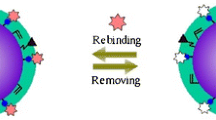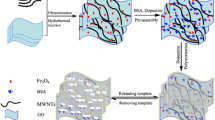Abstract
An approach using systematic component optimization for the formation of a molecularly imprinted polymer (MIP) has been adopted to imprint albumin. The result was a copolymer comprising 3-dimethylaminopropyl methacrylate and pentaerythritol tetraacrylate in a mole ratio of 1 to 11. Myoglobin was used in competitive re-binding experiments to compete with the polymer’s native template. The effects of monomer to crosslinker mole ratio, polymerization temperature and time were investigated. These results also showed that the MIP possessed a high selectivity and adsorption capacity with respect to albumin in competitive binding protocols when the interfering species was also present in solution. Polymerization temperature and time were all shown to have significant effects on the resulting albumin-MIP’s performance. Additionally, higher polymerization temperatures (> 38 °C) and extended polymerization times (> 48 h) increased monomer conversion as determined by HPLC, but decreased the selectivity and adsorption capacity of the MIP.






Similar content being viewed by others
References
Du J, Shen L, Lu J (2003) Flow injection chemiluminescence determination of epinephrine using epinephrine-imprinted polymer as recognition material. Anal Chim Acta 489:183
Hayden O, Bindeus R, Haderspo¨ck C, Mann K, Wirl B, Dickert FL (2003) Mass-sensitive detection of cells, viruses and enzymes with artificial receptors. Sens Actuators B 91:316
Dickert FL, Hayden O, Halikias KP (2001) Synthetic receptors as sensor coatings for molecules and living cells. Analyst 126:766
Ye L, Mosbach K (2001) Polymers recognizing biomolecules based on a combination of molecular imprinting and proximity scintillation: a new sensor concept. J Am Chem Soc 123:2901
Liang C, Peng H, Bao X, Nie L, Yao S (1999) Study of a molecular imprinting polymer coated BAW bio-mimic sensor and its application to the determination of caffeine in human serum and urine. Analyst 124:1781
Rezeli M, Kilár F, Hjertén S (2006) Monolithic beds of artificial gel antibodies. J Chromatogr A 1109:100
Cheng Z, Zhang L, Li Y (2004) Synthesis of an enzyme-like imprinted polymer with the substrate as the template, and its catalytic properties under aqueous conditions. Chem Eur J 10:3555
Takeuchi T, Mukawa T, Matsui J, Higashi M, Shimizu KD (2001) Molecularly imprinted polymers with metalloporphyrin-based molecular recognition sites coassembled with methacrylic acid. Anal Chem 73:3869
McCluskey A, Holdsworth CI, Bowyer MC (2007) Molecularly imprinted polymers (MIPs): sensing, an explosive new opportunity? Org Biomol Chem 5:3233
Fish WP, Ferreira J, Sheardy RD, Snow NH, O’Brien TP (2005) Rational design of an imprinted polymer: maximizing selectivity by optimizing the monomer-template ratio for a cinchonidine MIP, prior to polymerization, using microcalorimetry. J Liq Chromatogr Relat Technol 28:1
Cooper AI, Hems WP, Holmes AB (1999) Synthesis of highly cross-linked polymers in supercritical carbon dioxide by heterogeneous polymerization. Macromolecules 32:2156
Janiak DS, Kofinas P (2007) Molecular imprinting of peptides and proteins in aqueous media. Anal Bioanal Chem 389:399
Lin HY, Rick J, Chou TC (2007) Optimizing the formulation of a myoglobin molecularly imprinted thin-film polymer—formed using a micro-contact imprinting method. Biosens Bioelectron 22:3293
Hsu CY, Lin HY, Thomas JL, Wu BT, Chou TC (2006) Incorporation of styrene enhances recognition of ribonuclease A by molecularly imprinted polymers. Biosens Bioelectron 22:355
Syu MJ, Nian YM, Chang YS, Lin XZ, Shiesh SC, Chou TC (2006) Ionic effect on the binding of bilirubin to the imprinted poly(methacrylic acid-co-ethylene glycol dimethylacrylate). J Chromatogr A 1122:54
Ou SH, Wu MC, Chou TC, Liu CC (2004) Polyacrylamide gels with electrostatic functional groups for the molecular imprinting of lysozyme. Anal Chim Acta 504:163
Hu CH, Chou TC (2009) Albumin molecularly imprinted polymer with high template affinity — prepared by systematic optimization in mixed organic/ aqueous media. Microchem J 91:53
Xu Z, Liu L, Deng Q (2006) Study on the mechanism of binding specificity of metoclopramide-imprinted polymers. J Pharm Biomed Anal 41:701
Zhu QZ, Haupt K, Knopp D, Niessner R (2002) Molecularly imprinted polymer for metsulfuron-methyl and its binding characteristics for sulfonylurea herbicides. Anal Chim Acta 468:217
Idziak I, Benrebouh A, Deschamps F (2001) Simple NMR experiments as a means to predict the performance of an anti-17α-ethynylestradiol molecularly imprinted polymer. Anal Chim Acta 435:137
Yu C, Mosbach K (2000) Influence of mobile phase composition and cross-linking density on the enantiomeric recognition properties of molecularly imprinted polymers. J Chromatogr A 888:63
Piletsky SA, Piletska EV, Karim K, Freebairn KW, Legge CH, Turner APF (2002) Polymer cookery: influence of polymerization conditions on the performance of molecularly imprinted polymers. Macromolecules 35:7499
Takeda K, Wada A, Yamamoto K, Moriyama Y, Aoki K (1989) Conformational change of bovine serum albumin by heat treatment. J Protein Chem 8:653
Hart BR, Shea KJ (2002) Molecular imprinting for the recognition of N-Terminal Histidine peptides in aqueous solution. Macromolecules 35:6192
Acknowledgement
The support of the National Cheng Kung University and Tatung University are gratefully acknowledged.
Author information
Authors and Affiliations
Corresponding author
Rights and permissions
About this article
Cite this article
Hu, CH., Chou, TC. Albumin molecularly imprinted polymer prepared with a semi-rigid crosslinker in mixed organic/aqueous media. Microchim Acta 165, 399–405 (2009). https://doi.org/10.1007/s00604-009-0151-5
Received:
Accepted:
Published:
Issue Date:
DOI: https://doi.org/10.1007/s00604-009-0151-5




